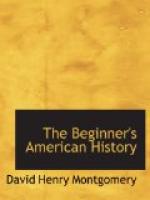Who was Henry Hudson? What did he try to find? What did the Dutch hire him to do? Where did he go? What did he call the river he discovered? What is said about that river? Tell what you can of Hudson’s voyage up the river. What is said about the Indians? Why did Hudson turn back? What did he do then? What is the river he discovered called now? What happened to Captain Hudson the next year? What did the Dutch do? What did they name the country? Why? What did they build there on Manhattan Island? Who seized New Netherland? What name did they give it? What is said of the “Sons of Liberty”? What would Hudson say if he could see New York City now?
Captain Myles[1] Standish
(1584-1656).
62. The English Pilgrims in Holland; why they left England.—When the news of Henry Hudson’s discovery of the Hudson River reached Holland, many Englishmen were living in the Dutch city of Leyden.[2] These people were mostly farmers who had fled from Scrooby[3] and neighboring villages in the northeast of England. They called themselves Pilgrims, because they were wanderers from their old homes.
The Pilgrims left England because King James would not let them hold their religious meetings in peace. He thought, as all kings then did, that everybody in England should belong to the same church and worship God in the same way that he did.[4] He was afraid that if people were allowed to go to whatever church they thought best that it would lead to disputes and quarrels, which would end by breaking his kingdom to pieces. Quite a number of Englishmen, seeing that they could not have religious liberty at home, escaped with their wives and children to Holland; for there the Dutch were willing to let them have such a church as they wanted.
[Illustration: Map of England and Holland]
[Footnote 1: Myles (Miles): Standish himself wrote it Myles.]
[Footnote 2: Leyden (Li’den): see map in this paragraph.]
[Footnote 3: Scrooby (Skroo’bi): see map in this paragraph.]
[Footnote 4: There were some people in England who thought much as the Pilgrims did in regard to religion, but who did not then leave the Church of England (as the Pilgrims did). They were called Puritans because they insisted on making certain changes in the English mode of worship, or, as they said, they wished to purify it. Many Puritans came to New England with Governor Winthrop in 1630; after they settled in America they established independent churches like the Pilgrims.]
63. Why the Pilgrims wished to leave Holland and go to America.—But the Pilgrims were not contented in Holland. They saw that if they staid in that country their children would grow up to be more Dutch than English. They saw, too, that they could not hope to get land in Holland. They resolved therefore to go to America, where they could get farms for nothing, and where their children would never forget the English language or the good old English customs and laws. In the wilderness they would not only enjoy entire religious freedom, but they could build up a settlement which would be certainly their own.




